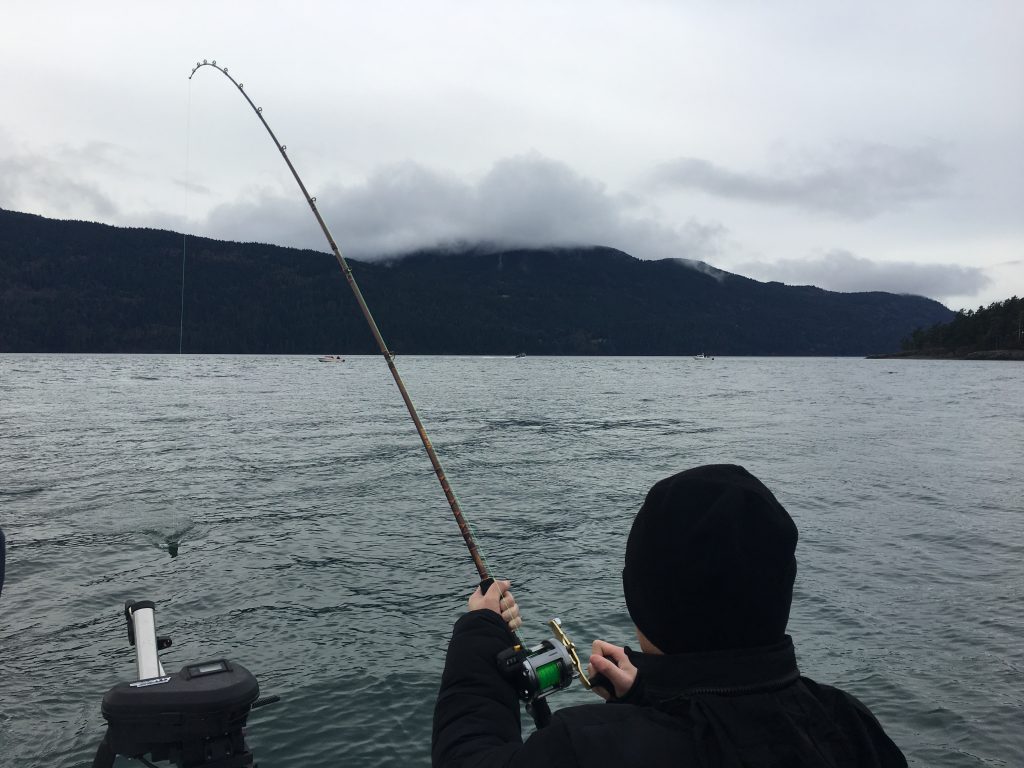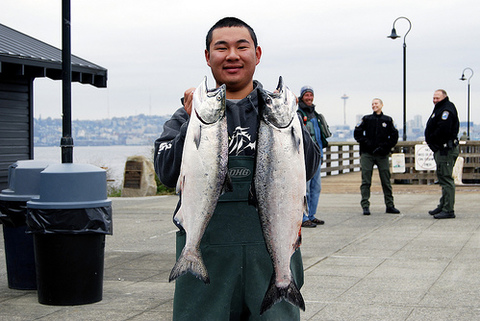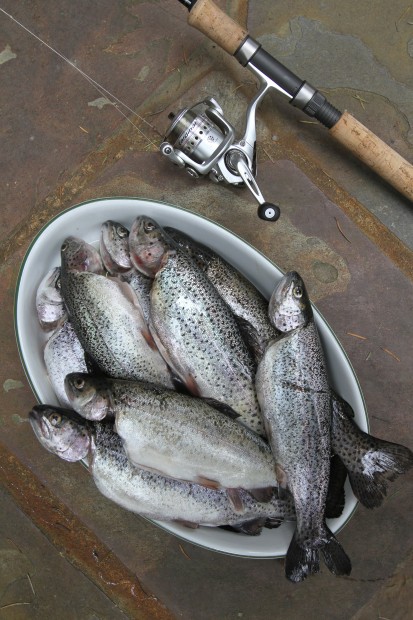Winter blackmouth fisheries ramp up after New Year’s Eve in three prime locations 1
Thousands of anglers will try their luck starting Jan. 1 to catch a nice hatchery chinook like Tegan Yuasa who hooked this fish at Point No Point in winter of 2018.
The big party isn’t happening on New Year’s Eve, but the following morning (Jan. 1) when three highly-popular marine salmon fishing areas reopen for hatchery-marked chinook.
Northern and central Puget Sound and the San Juan Islands (Marine Catch Areas 7, 9 and 10) are the most hyped salmon fishing destinations in this region and anglers will be licking their chops since success in the winter-time can be better than summer.
“Areas 9 and 10 are both good bets for the opener, and Jefferson Head was alive with baitfish and blackmouth (a term used to describe chinook for their black gumline) before it closed (on Nov. 15),” said Justin Wong, owner of Cut Plug Charter in Seattle. “Possession Bar will also be hard to beat when it comes to blackmouth fishing.”
Being flexible on when to hit the water is the key during the winter as Puget Sound can be a dicey place to fish especially during windy and rainy days although there will be those “Kodak” moments when it is flat, calm with picturesque views of the snow Cascade and Olympic mountains and a chinook tugging on the end of your line.
Wong offers some key tips in the winter to follow and tops on the list s locating schools of herring and candlefish since winter resident chinook are constantly on the hunt for their prey.
“Once you locate the bait stay on top of them as long as you can,” he said.
Wong also points out that winter chinook often lurk right off the bottom so keeping your lure or bait near the surface or mid-water column depths lessens your chances of hooking a fish.
Timing and being at the right place at the right time during a certain tidal movement is key. That means is the fish bit at a certain time of the day, it’s a sure thing they’ll do the same the following day only an hour later.
In the Puget Sound area see-out blackmouth at Possession Bar; Pilot Point; Point No Point; Midchannel Bank off Port Townsend; Double Bluff off southwest side of Whidbey Island; Pilot Point; Jefferson Head; West Point south of Shilshole Bay; Point Monroe; Fourmile Rock; Rich Passage; Southworth; Manchester; northwest side of Vashon Island by channel marker; and Allen Bank off Blake Island’s southeastern corner.
The San Juan Islands are by far the best location for winter fishing around Waldron Island; Parker Reef; north side Orcas Island; Rosario Pass; Tide Point; Obstruction Pass; Salmon Bank; Point Lawrence; and Thatcher Pass.

The winter chinook fisheries are dependent on millions of young fish raised and kept in hatcheries for one year before releasing them. This delayed release reprograms many of the chinook to stick around close to home, where they’ll feed and grow for two to three years instead of migrating out to the ocean.
In the hatcheries, these fish have their adipose fin clipped so anglers can tell the difference between them and an unmarked wild fish.
Be sure to take into consideration that getting out sooner than later is more important than anything mentioned above because early closures hinge on catch guidelines or encounter limits for sub-legal and legal-size chinook (the minimum size limit is 22 inches).
The San Juan Islands (Area 7) has a ceiling of 3,176 total unmarked encounters and/or 11,867 total encounters wild and hatchery fish. WDFW will provide in-season catch estimates around Jan. 11.
In northern Puget Sound (Area 9) the encounter prediction is 10,004 chinook; and in central Puget Sound (Area 10) it is 3,596. WDFW will provide in-season catch estimates for 9 and 10 around Jan. 18.
The daily limit will be one hatchery-marked chinook in the three areas with a minimum size limit of 22-inches.
Tengu Derby starts this coming Sunday
The Tengu Blackmouth Derby the oldest salmon derby – an event that began prior to and shortly after World War II in 1946 – will be held on Sundays 6 a.m. to 11 a.m. from Jan. 6 through Feb. 24 on Elliott Bay at the Seacrest Boathouse (now known as Marination) in West Seattle.
Normally the derby (the oldest Puget Sound) starts in October when Area 10 opens for winter hatchery chinook. However, this year’s non-retention of chinook delayed the event to coincide with the Jan. 1 reopener of Area 10.
Besides the unpredictable winter weather what makes the derby so challenging is the simple fact that blackmouth are scarce in the inner-bay during the winter months.

The derby is named after Tengu, a fabled Japanese character who stretched the truth, and just like Pinocchio, Tengu’s nose grew with every lie.
In a typical derby season, the catch ranges from 20 to 23 legal-size chinook and has reached as high as 50 to 100 fish although catches have dipped dramatically since 2009. The record-low catch was four fish in 2010, and all-time high was 234 in 1979.
Last year, a total of 18 blackmouth were caught and the winning fish of 9 pounds-15 ounces went to Guy Mamiya. Justin Wong had the most fish with a total of five and followed by John Mirante with four fish.
It has been a while since a big fish was caught in the derby dating back to 1958 when Tom Osaki landed a 25-3 fish. In the past decade, the largest was 15-5 caught by Marcus Nitta during the 2008 derby.
To further test your skills, only mooching is allowed in the derby. No artificial lures, flashers, hoochies (plastic squids) or other gear like downriggers are permitted. The membership fee is $15 and $5 for children age 12-and-under. Tickets are available at Outdoor Emporium in Seattle. Rental boats are available from 7 a.m. to 11 a.m. for $65 boat, and $85 for boat and motor.
Trout plants boost winter action

It’s going to be a happy holiday period for anglers pursuing freshly planted trout in local lakes open year-round to fishing!
In King County, Beaver Lake was planted on Dec. 18 with 906 trout averaging 1.5 pounds apiece.
In Lewis County, Carlisle Lake got a plant of 125 trout on Dec. 17. In Cowlitz County, Horseshoe Lake was planted with 86 trout on Dec. 18; Lake Sacajawea got 640 on Dec. 18. In Klickitat County, Rowland Lake got 4,000 trout on Dec. 17-18.
For plants, go to https://wdfw.wa.gov/fishing/plants/weekly/.



Just getting back into trolling for salmon again. What is a good downrigger rod these days?